(Forsskal, 1775); CARANGIDAE FAMILY; also called turrum or ulua, previously known by the misnomers “lowly” or “lesser” trevally
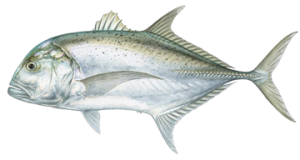
Inhabits coral and rock reefs in warm coastal waters of the Indian and central Pacific Oceans, eastward to the Hawaiian and Marquesas Islands. Common in the waters off Kenya and other parts of Africa as well as off Australia, New Zealand, the Philippines, Malaysia, and Hawaii. This is the most common of the trevallys found in Hawaii’s and Kenya’s waters.
The giant trevally, which grows to over 130 lb (62 kg), is the largest of the eight Caranx species which occur in the Indo Pacific region. It has a small oval shaped patch of scales in the center of the larger scaleless area on the breast in front of the ventral fins, distinguishing it from the bigeye trevally (Caranx (Caranx) sexfasciatus) whose breast is fully scaled. In some specimens (about 5%) this oval patch of scales is extensive enough to make detection of the scaleless area difficult. The body and head are usually very deep with a blunt snout. The lateral line is strongly curved anteriorly. The straight portion is covered with scutes; 25 33 in the giant trevally and 28 37 in the bigeye. The first dorsal fin consists of 8 spines, the second of 17 21 soft rays, and anal fin of 3 spines and 15 17 soft rays. Gill rakers on the first arch total 18 23. There is no spot on the operculum such as is found on the bigeye trevally, nor is there a spot at the base of the pectoral fins such as appears on the crevalle jacks (Caranx hippos and Caranx caninus), the close Atlantic and eastern Pacific relatives of this species.
Adults are sedentary, prefer rocky areas near shore or outside reef drop offs, and feed most actively at night. Hawaiian anglers report that the darker the night the more actively they feed. It is a highly rated sport fish in the waters of Hawaii and Kenya both for its large size and for the hard fight it gives. Fishing methods include surf fishing, drifting, or still fishing using live or cut baits. Trolling with baits and lures can also bring results. Baits and lures include mullet, herring, sauri, garfish, anchovy, squid, cut strip baits, Konaheads, knuckleheads, bulletheads, feathers, plastic jigs, plastic fish and squids, drone spoons, and rope lures. The pinkish flesh is highly esteemed as food in some areas and is also frequently used for strip baits, cut baits or chum
from https://www.igfa.org/


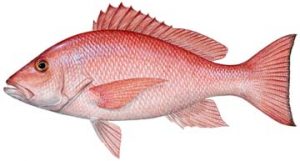 (Poey 1860); LUTJANIDAE FAMILY; also called northern red snapper, pargo colorado, vermelho, pargo del golfo, huachinango del Golfo,
(Poey 1860); LUTJANIDAE FAMILY; also called northern red snapper, pargo colorado, vermelho, pargo del golfo, huachinango del Golfo,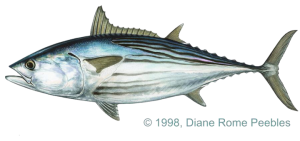 Kishinouye, 1920; SCOMBRIDAE FAMILY; also called little tuna, false albacore, spotted tuna, mackerel tuna, skipjack
Kishinouye, 1920; SCOMBRIDAE FAMILY; also called little tuna, false albacore, spotted tuna, mackerel tuna, skipjack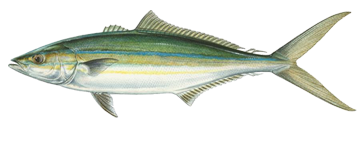
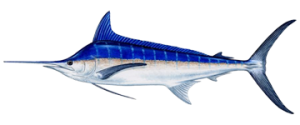 Lacepede, 1802; ISTIOPHORIDAE FAMILY
Lacepede, 1802; ISTIOPHORIDAE FAMILY (Mitchill, 1815); SCOMBRIDAE FAMILY
(Mitchill, 1815); SCOMBRIDAE FAMILY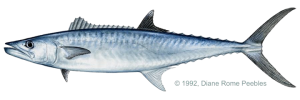 (Cuvier, 1829); SCOMBRIDAE FAMILY; also called kingfish, giant mackerel
(Cuvier, 1829); SCOMBRIDAE FAMILY; also called kingfish, giant mackerel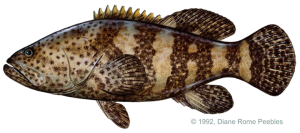 (Lichtenstein, 1822); SERRANIDAE FAMILY; also called spotted jewfish, southern jewfish, junefish, Florida jewfish, jewfish
(Lichtenstein, 1822); SERRANIDAE FAMILY; also called spotted jewfish, southern jewfish, junefish, Florida jewfish, jewfish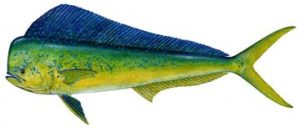 Linnaeus, 1758; CORYPHAENIDAE FAMILY; also called dolphin, mahi mahi, dorado, goldmakrele, shiira.
Linnaeus, 1758; CORYPHAENIDAE FAMILY; also called dolphin, mahi mahi, dorado, goldmakrele, shiira.